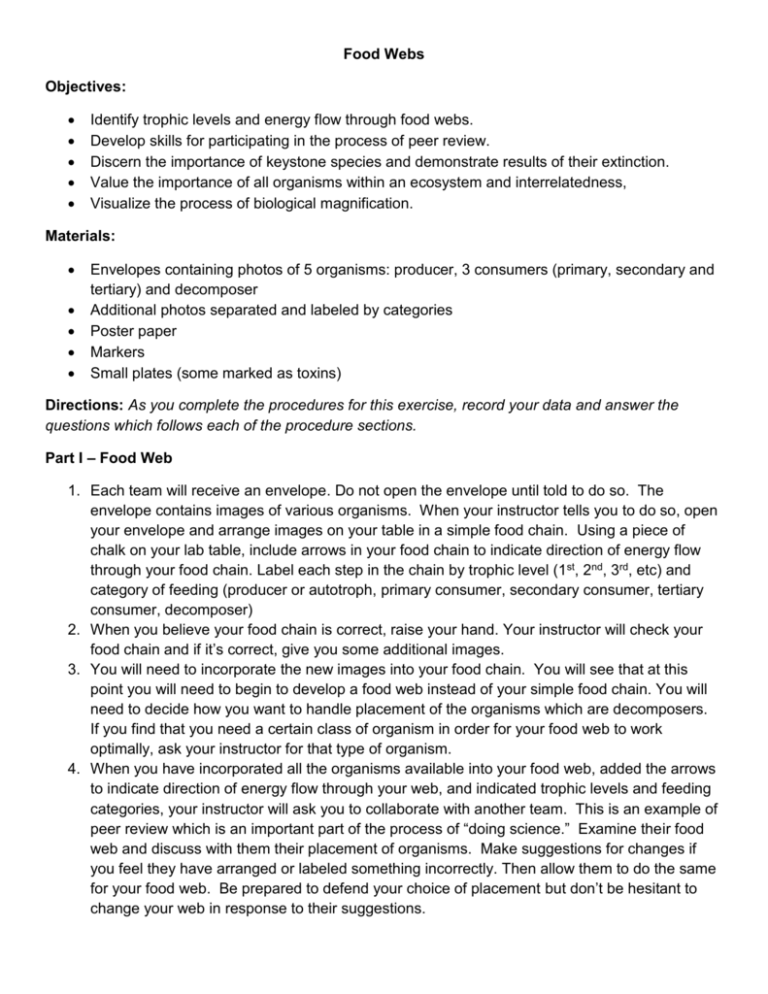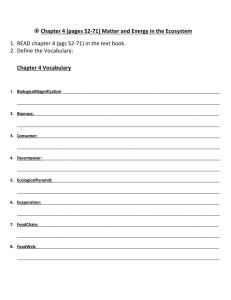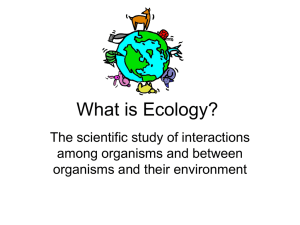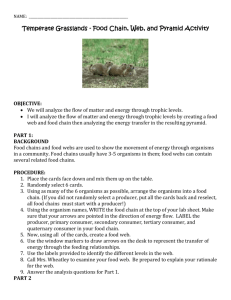Day 1 _ APES Food Webs _ Biomagnification
advertisement

Food Webs Objectives: Identify trophic levels and energy flow through food webs. Develop skills for participating in the process of peer review. Discern the importance of keystone species and demonstrate results of their extinction. Value the importance of all organisms within an ecosystem and interrelatedness, Visualize the process of biological magnification. Materials: Envelopes containing photos of 5 organisms: producer, 3 consumers (primary, secondary and tertiary) and decomposer Additional photos separated and labeled by categories Poster paper Markers Small plates (some marked as toxins) Directions: As you complete the procedures for this exercise, record your data and answer the questions which follows each of the procedure sections. Part I – Food Web 1. Each team will receive an envelope. Do not open the envelope until told to do so. The envelope contains images of various organisms. When your instructor tells you to do so, open your envelope and arrange images on your table in a simple food chain. Using a piece of chalk on your lab table, include arrows in your food chain to indicate direction of energy flow through your food chain. Label each step in the chain by trophic level (1st, 2nd, 3rd, etc) and category of feeding (producer or autotroph, primary consumer, secondary consumer, tertiary consumer, decomposer) 2. When you believe your food chain is correct, raise your hand. Your instructor will check your food chain and if it’s correct, give you some additional images. 3. You will need to incorporate the new images into your food chain. You will see that at this point you will need to begin to develop a food web instead of your simple food chain. You will need to decide how you want to handle placement of the organisms which are decomposers. If you find that you need a certain class of organism in order for your food web to work optimally, ask your instructor for that type of organism. 4. When you have incorporated all the organisms available into your food web, added the arrows to indicate direction of energy flow through your web, and indicated trophic levels and feeding categories, your instructor will ask you to collaborate with another team. This is an example of peer review which is an important part of the process of “doing science.” Examine their food web and discuss with them their placement of organisms. Make suggestions for changes if you feel they have arranged or labeled something incorrectly. Then allow them to do the same for your food web. Be prepared to defend your choice of placement but don’t be hesitant to change your web in response to their suggestions. Part 1 – Data Trophic Level Species Found to Feed in that Trophic Level Part 1 – Analysis 1. Where in the food web did you place the organisms which are decomposers? Explain your rationale for that design. 2. List in the table, the type of organisms you needed to request specifically in order to make your food web work. What was the reason for requesting them? 3. Which trophic level in your food web contains the biggest energy investment? 4. If you are concerned about eating a diet which conserves the world’s energy, where in the food chain should you eat? Part II – Extinction and Keystone Species 1. Once you return to your food web, your instructor will remove one or more organisms from your web. This represents an extinction event in your ecosystem. Discuss with your team the various results of that species being removed from your web. Record your answers in the data table. 2. Determine which organisms will benefit from the extinction and which ones will be harmed by this event. Be sure to look at the indirect effects as well as the direct ones. Record your answers. 3. Discuss whether this extinction will lead to increased interspecific competition and which species will be affected. 4. Indicate in the analysis, if any, of the organisms that were removed are keystone species? How can you tell? Part II – Data When the instructor removed one or more species from your web what were the results of that species being removed? Species Removed Results of Removal Part II – Analysis 1. 2. 3. 4. Define keystone species. Did your food web have any keystone species? Which organism were they? List the removed organisms which were keystone species. How can you tell? What are some possible impacts of the extinction of 3 other species in your food web? Part III – Simulated Biological Magnification 1. Each student will be assigned to a trophic level before going to the school gymnasium. As you walk over think of the following: Why are there many primary consumers but only very few tertiary or quaternary consumers? 2. All students will arrange themselves by trophic levels as in the Pyramid of Productivity. Producers will arrange themselves in at the bottom of the bleachers (which represent the base of the pyramid) with Primary Consumers above them, the Secondary Consumers and so on until the Top Carnivores are located at the very peak of the pyramid. 3. The instructor will provide the autotrophs with the food particles (small plates) that these producers have manufactured through photosynthesis or chemosynthesis. Some of these building blocks look different that others with colored circle, but they are equally attractive and nutritious to the producers. 4. Primary consumers will now feed upon the producers by taking their plates (which represent food particles) away from the producers one particle at a time until the instructor calls a time limit. The primary consumers are simulating feeding by taking the collected food particles from each producer fed upon. This step could represent a deer grazing on grass, or bird eating seeds, or other feeding that a primary consumer might do. 5. Secondary consumers will then feed upon primary consumers. The secondary consumers indicated feeding by taking the collected food particles from each primary consumer fed upon. The instructor will call a time limit. 6. Tertiary, then quaternary, consumers will feed in a similar manner until all members of the pyramid at every trophic level have had a chance to feed. As the game procees, there will be more of the toxic particles (hh) per person with each succeeding trophic level. At the end of the game when everyone has fed, you’ll probably have most of the toxic particles in the top carnivores at the top of the food chain. 7. Examine the food held by each top carnivore. This food will be incorporated into his body. A dot indicates toxins which have traveled through the food chain. The more dots you have the higher your toxin level is. 8. Add your individual data to the table in Part C of the Data Collection and Analysis section, and collate data from the entire class. Answer the questions and complete the pyramid in that section. Part III – Data Food particles Producers 10 consumer 20 consumer 30 consumer 40 consumer Comments # Non-toxic #Toxin/ individual Total food collected % Food containing toxins Part III – Data Analysis 1. Explain what happened as the toxins moved up the food chain? 2. Why were there a lot of primary consumers in your productivity pyramid but only very few tertiary or quaternary consumers? Is this true in nature? Why? 3. Based on exercise, where in the food chain should you feed if you are interested in reducing the amount of potential toxins in your diet? 4. Heavy metals like mercury (Hg) are contaminating marine organisms such as tuna resulting in suggested limits on human consumption of these organisms. Discuss why certain animals may contain dangerous levels while others do not. Then explain how toxins get to such dangerous levels, especially in the top predators. 5. Construct a triangle and create a productivity pyramid using the following terms: producers, primary consumers, secondary consumers, tertiary consumers, quaternary consumers. Give an example of a specific organism for each of the terms. 6. In the pyramid, indicate the percent of energy which is passed on to the next trophic level, and the percent that is “lost” to the system. For help see the diagram in your textbooks. 7. List and explain the Laws of Thermodynamics which apply. 8. Explain why less than 100% of the energy contained in one level is passed on to the next, and indicate what happens to it.









